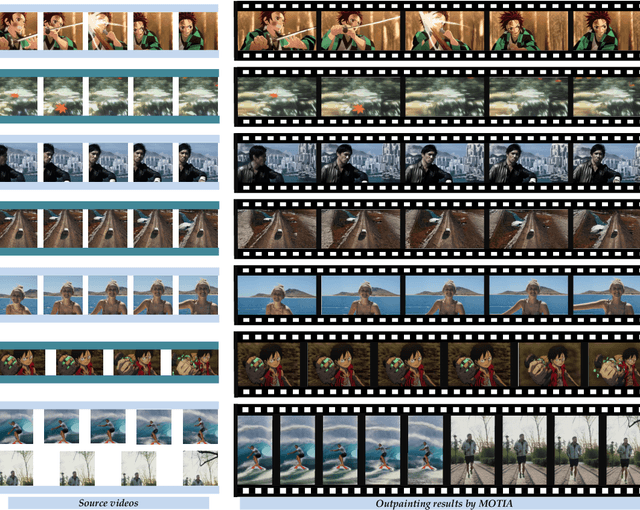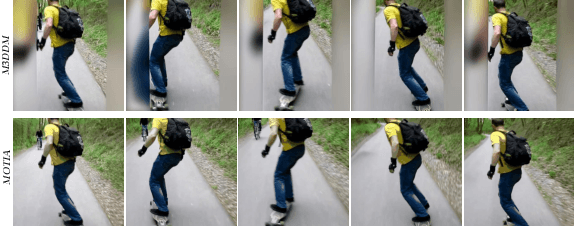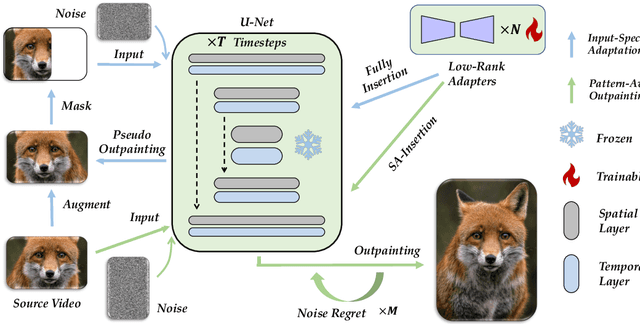Fu-Yun Wang
GS-DiT: Advancing Video Generation with Pseudo 4D Gaussian Fields through Efficient Dense 3D Point Tracking
Jan 05, 2025



Abstract:4D video control is essential in video generation as it enables the use of sophisticated lens techniques, such as multi-camera shooting and dolly zoom, which are currently unsupported by existing methods. Training a video Diffusion Transformer (DiT) directly to control 4D content requires expensive multi-view videos. Inspired by Monocular Dynamic novel View Synthesis (MDVS) that optimizes a 4D representation and renders videos according to different 4D elements, such as camera pose and object motion editing, we bring pseudo 4D Gaussian fields to video generation. Specifically, we propose a novel framework that constructs a pseudo 4D Gaussian field with dense 3D point tracking and renders the Gaussian field for all video frames. Then we finetune a pretrained DiT to generate videos following the guidance of the rendered video, dubbed as GS-DiT. To boost the training of the GS-DiT, we also propose an efficient Dense 3D Point Tracking (D3D-PT) method for the pseudo 4D Gaussian field construction. Our D3D-PT outperforms SpatialTracker, the state-of-the-art sparse 3D point tracking method, in accuracy and accelerates the inference speed by two orders of magnitude. During the inference stage, GS-DiT can generate videos with the same dynamic content while adhering to different camera parameters, addressing a significant limitation of current video generation models. GS-DiT demonstrates strong generalization capabilities and extends the 4D controllability of Gaussian splatting to video generation beyond just camera poses. It supports advanced cinematic effects through the manipulation of the Gaussian field and camera intrinsics, making it a powerful tool for creative video production. Demos are available at https://wkbian.github.io/Projects/GS-DiT/.
BlinkVision: A Benchmark for Optical Flow, Scene Flow and Point Tracking Estimation using RGB Frames and Events
Oct 27, 2024Abstract:Recent advances in event-based vision suggest that these systems complement traditional cameras by providing continuous observation without frame rate limitations and a high dynamic range, making them well-suited for correspondence tasks such as optical flow and point tracking. However, there is still a lack of comprehensive benchmarks for correspondence tasks that include both event data and images. To address this gap, we propose BlinkVision, a large-scale and diverse benchmark with multiple modalities and dense correspondence annotations. BlinkVision offers several valuable features: 1) Rich modalities: It includes both event data and RGB images. 2) Extensive annotations: It provides dense per-pixel annotations covering optical flow, scene flow, and point tracking. 3) Large vocabulary: It contains 410 everyday categories, sharing common classes with popular 2D and 3D datasets like LVIS and ShapeNet. 4) Naturalistic: It delivers photorealistic data and covers various naturalistic factors, such as camera shake and deformation. BlinkVision enables extensive benchmarks on three types of correspondence tasks (optical flow, point tracking, and scene flow estimation) for both image-based and event-based methods, offering new observations, practices, and insights for future research. The benchmark website is https://www.blinkvision.net/.
Stable Consistency Tuning: Understanding and Improving Consistency Models
Oct 24, 2024



Abstract:Diffusion models achieve superior generation quality but suffer from slow generation speed due to the iterative nature of denoising. In contrast, consistency models, a new generative family, achieve competitive performance with significantly faster sampling. These models are trained either through consistency distillation, which leverages pretrained diffusion models, or consistency training/tuning directly from raw data. In this work, we propose a novel framework for understanding consistency models by modeling the denoising process of the diffusion model as a Markov Decision Process (MDP) and framing consistency model training as the value estimation through Temporal Difference~(TD) Learning. More importantly, this framework allows us to analyze the limitations of current consistency training/tuning strategies. Built upon Easy Consistency Tuning (ECT), we propose Stable Consistency Tuning (SCT), which incorporates variance-reduced learning using the score identity. SCT leads to significant performance improvements on benchmarks such as CIFAR-10 and ImageNet-64. On ImageNet-64, SCT achieves 1-step FID 2.42 and 2-step FID 1.55, a new SoTA for consistency models.
Rectified Diffusion: Straightness Is Not Your Need in Rectified Flow
Oct 09, 2024Abstract:Diffusion models have greatly improved visual generation but are hindered by slow generation speed due to the computationally intensive nature of solving generative ODEs. Rectified flow, a widely recognized solution, improves generation speed by straightening the ODE path. Its key components include: 1) using the diffusion form of flow-matching, 2) employing $\boldsymbol v$-prediction, and 3) performing rectification (a.k.a. reflow). In this paper, we argue that the success of rectification primarily lies in using a pretrained diffusion model to obtain matched pairs of noise and samples, followed by retraining with these matched noise-sample pairs. Based on this, components 1) and 2) are unnecessary. Furthermore, we highlight that straightness is not an essential training target for rectification; rather, it is a specific case of flow-matching models. The more critical training target is to achieve a first-order approximate ODE path, which is inherently curved for models like DDPM and Sub-VP. Building on this insight, we propose Rectified Diffusion, which generalizes the design space and application scope of rectification to encompass the broader category of diffusion models, rather than being restricted to flow-matching models. We validate our method on Stable Diffusion v1-5 and Stable Diffusion XL. Our method not only greatly simplifies the training procedure of rectified flow-based previous works (e.g., InstaFlow) but also achieves superior performance with even lower training cost. Our code is available at https://github.com/G-U-N/Rectified-Diffusion.
Trans4D: Realistic Geometry-Aware Transition for Compositional Text-to-4D Synthesis
Oct 09, 2024Abstract:Recent advances in diffusion models have demonstrated exceptional capabilities in image and video generation, further improving the effectiveness of 4D synthesis. Existing 4D generation methods can generate high-quality 4D objects or scenes based on user-friendly conditions, benefiting the gaming and video industries. However, these methods struggle to synthesize significant object deformation of complex 4D transitions and interactions within scenes. To address this challenge, we propose Trans4D, a novel text-to-4D synthesis framework that enables realistic complex scene transitions. Specifically, we first use multi-modal large language models (MLLMs) to produce a physic-aware scene description for 4D scene initialization and effective transition timing planning. Then we propose a geometry-aware 4D transition network to realize a complex scene-level 4D transition based on the plan, which involves expressive geometrical object deformation. Extensive experiments demonstrate that Trans4D consistently outperforms existing state-of-the-art methods in generating 4D scenes with accurate and high-quality transitions, validating its effectiveness. Code: https://github.com/YangLing0818/Trans4D
OSV: One Step is Enough for High-Quality Image to Video Generation
Sep 17, 2024



Abstract:Video diffusion models have shown great potential in generating high-quality videos, making them an increasingly popular focus. However, their inherent iterative nature leads to substantial computational and time costs. While efforts have been made to accelerate video diffusion by reducing inference steps (through techniques like consistency distillation) and GAN training (these approaches often fall short in either performance or training stability). In this work, we introduce a two-stage training framework that effectively combines consistency distillation with GAN training to address these challenges. Additionally, we propose a novel video discriminator design, which eliminates the need for decoding the video latents and improves the final performance. Our model is capable of producing high-quality videos in merely one-step, with the flexibility to perform multi-step refinement for further performance enhancement. Our quantitative evaluation on the OpenWebVid-1M benchmark shows that our model significantly outperforms existing methods. Notably, our 1-step performance(FVD 171.15) exceeds the 8-step performance of the consistency distillation based method, AnimateLCM (FVD 184.79), and approaches the 25-step performance of advanced Stable Video Diffusion (FVD 156.94).
Phased Consistency Model
May 28, 2024Abstract:The consistency model (CM) has recently made significant progress in accelerating the generation of diffusion models. However, its application to high-resolution, text-conditioned image generation in the latent space (a.k.a., LCM) remains unsatisfactory. In this paper, we identify three key flaws in the current design of LCM. We investigate the reasons behind these limitations and propose the Phased Consistency Model (PCM), which generalizes the design space and addresses all identified limitations. Our evaluations demonstrate that PCM significantly outperforms LCM across 1--16 step generation settings. While PCM is specifically designed for multi-step refinement, it achieves even superior or comparable 1-step generation results to previously state-of-the-art specifically designed 1-step methods. Furthermore, we show that PCM's methodology is versatile and applicable to video generation, enabling us to train the state-of-the-art few-step text-to-video generator. More details are available at https://g-u-n.github.io/projects/pcm/.
Rethinking the Spatial Inconsistency in Classifier-Free Diffusion Guidance
Apr 08, 2024Abstract:Classifier-Free Guidance (CFG) has been widely used in text-to-image diffusion models, where the CFG scale is introduced to control the strength of text guidance on the whole image space. However, we argue that a global CFG scale results in spatial inconsistency on varying semantic strengths and suboptimal image quality. To address this problem, we present a novel approach, Semantic-aware Classifier-Free Guidance (S-CFG), to customize the guidance degrees for different semantic units in text-to-image diffusion models. Specifically, we first design a training-free semantic segmentation method to partition the latent image into relatively independent semantic regions at each denoising step. In particular, the cross-attention map in the denoising U-net backbone is renormalized for assigning each patch to the corresponding token, while the self-attention map is used to complete the semantic regions. Then, to balance the amplification of diverse semantic units, we adaptively adjust the CFG scales across different semantic regions to rescale the text guidance degrees into a uniform level. Finally, extensive experiments demonstrate the superiority of S-CFG over the original CFG strategy on various text-to-image diffusion models, without requiring any extra training cost. our codes are available at https://github.com/SmilesDZgk/S-CFG.
Be-Your-Outpainter: Mastering Video Outpainting through Input-Specific Adaptation
Mar 20, 2024



Abstract:Video outpainting is a challenging task, aiming at generating video content outside the viewport of the input video while maintaining inter-frame and intra-frame consistency. Existing methods fall short in either generation quality or flexibility. We introduce MOTIA Mastering Video Outpainting Through Input-Specific Adaptation, a diffusion-based pipeline that leverages both the intrinsic data-specific patterns of the source video and the image/video generative prior for effective outpainting. MOTIA comprises two main phases: input-specific adaptation and pattern-aware outpainting. The input-specific adaptation phase involves conducting efficient and effective pseudo outpainting learning on the single-shot source video. This process encourages the model to identify and learn patterns within the source video, as well as bridging the gap between standard generative processes and outpainting. The subsequent phase, pattern-aware outpainting, is dedicated to the generalization of these learned patterns to generate outpainting outcomes. Additional strategies including spatial-aware insertion and noise travel are proposed to better leverage the diffusion model's generative prior and the acquired video patterns from source videos. Extensive evaluations underscore MOTIA's superiority, outperforming existing state-of-the-art methods in widely recognized benchmarks. Notably, these advancements are achieved without necessitating extensive, task-specific tuning.
AnimateLCM: Accelerating the Animation of Personalized Diffusion Models and Adapters with Decoupled Consistency Learning
Feb 01, 2024



Abstract:Video diffusion models has been gaining increasing attention for its ability to produce videos that are both coherent and of high fidelity. However, the iterative denoising process makes it computationally intensive and time-consuming, thus limiting its applications. Inspired by the Consistency Model (CM) that distills pretrained image diffusion models to accelerate the sampling with minimal steps and its successful extension Latent Consistency Model (LCM) on conditional image generation, we propose AnimateLCM, allowing for high-fidelity video generation within minimal steps. Instead of directly conducting consistency learning on the raw video dataset, we propose a decoupled consistency learning strategy that decouples the distillation of image generation priors and motion generation priors, which improves the training efficiency and enhance the generation visual quality. Additionally, to enable the combination of plug-and-play adapters in stable diffusion community to achieve various functions (e.g., ControlNet for controllable generation). we propose an efficient strategy to adapt existing adapters to our distilled text-conditioned video consistency model or train adapters from scratch without harming the sampling speed. We validate the proposed strategy in image-conditioned video generation and layout-conditioned video generation, all achieving top-performing results. Experimental results validate the effectiveness of our proposed method. Code and weights will be made public. More details are available at https://github.com/G-U-N/AnimateLCM.
 Add to Chrome
Add to Chrome Add to Firefox
Add to Firefox Add to Edge
Add to Edge